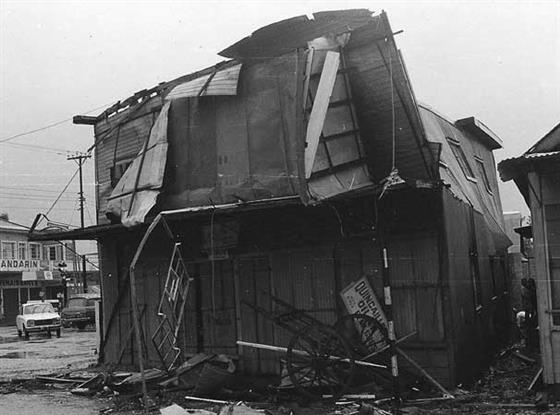Cyclones in Mauritius
As Mauritius is found in the inter tropical belt, at least one cyclone with wind speed of more than 120km/h hits the island per year. In this part of the world, on average four cyclones form during the summer times especially in the months of January to March.
Gervaise cyclone devastation in 1975, picture credit hunneybell.com

Cyclones are caused by a system of low pressure in the atmosphere with an area of higher pressure in the surroundings. This is often associated with strong winds and a lot of rainfall. Cyclones started to be named in 1960 in Mauritius which is also the year that one of the most devastating cyclones, Carol, hit the island. While Mauritius, Madagascar, Seychelles and Comores use a common cyclone list name, Mauritius names cyclones formed between longitude 55°E and 90°E, Madagascar west of 55°E and Australia east of 90°.
Cyclone nomenclature in the South West Indian Ocean
Cyclones in the South West part of the Indian Ocean can be classified as:
- tropical disturbance (low pressure area with scattered clouds)
- tropical depression (low pressure system evolving over tropical waters with clockwise circulating winds with gusts less than 89km/h)
- moderate tropical storm (low pressure system evolving over tropical waters with definite cyclonic characteristics and circulating winds with gusts between 89km/h and 124km/h)
- severe tropical storm (definite cyclone with winds between 125km/h and 165km/h)
- tropical cyclone (definite cyclone with gusts between 166km/h and 233km/h)
- intense tropical cyclone (cyclone with gusts between 234km/h and 299km/h)
- very intense tropical cyclone (winds over 300km/h).
Mauritius cyclone warning system
The warning system can be classified into 4 parts:
- class I, where warning is issued 36-48hrs before the island is hit by gusts up to 120km/h
- class II, issued to ensure at least 12 hours of daylight before the island is hit by gusts of 120km/h
- class III, issued in order to give 6 hours of daylight before the occurrence of winds of 120km/h
- class IV when gusts of 120km/h are recorded and expected to continue
All warnings are removed when gusts of 120km/h are no longer a danger to the island.
Worst cyclones which have hit Mauritius
Some of the worst cyclones Mauritius had to deal with were:
- Carol - 1960, gusts of 256km/h
- Alix - 1960, gusts of 200km/h
- Jenny - 1962, gusts of 235km/h
- Gervaise - 1975, gusts of 280km/h
- Hollanda - 1994, 216km/h
- Dina - 2002, 228km/h
The met service has a complete list of historical cyclones.
How to prepare for a cyclone
In the face of a coming cyclone, it is advised of the public to make sure that the house is in good condition and can withstand strong winds, to cut tree branches that may do damage in some way and to remove loose materials from the yard etc to prevent injury, to secure boats tightly somewhere, to get acquainted with refuge centres in the area and to store food/clothes/candles/torches/medicine/water.
- During class I cyclones, monitor the situation on radio/TV and secure all windows and doors with your emergency kit at hand
- At class II, continue to monitor on radio/TV and store some water in case of shortage
- At class III, make sure that your house, vehicles and animals have been thoroughly secured, be on your guard and follow the development of the cyclone on radio/TV, stay inside and move to refuge centres if necessary
- At class IV, you should not even go outside, take shelter in the safest part of the house covering yourself with mattress, rugs and blankets in case of damage to the house, disconnect all electrical appliances and continue to monitor the progress of the cyclone. Do not go outside during the passage of the eye of the cyclone because even though it may look like a calm period, strong winds usually follow.
What to do after a cyclone
After the passage of a cyclone, you can leave the centre once all warnings are cleared. Remove all stagnant water to prevent the proliferation of insects and diseases, boil water before use and do not eat fallen fruits. Watch out for broken lines and branches when you go outside.


